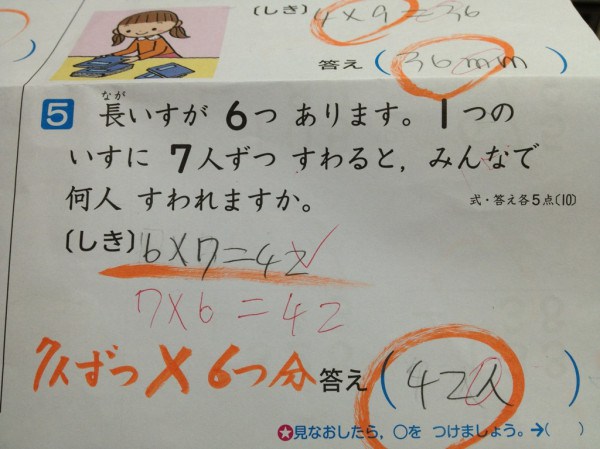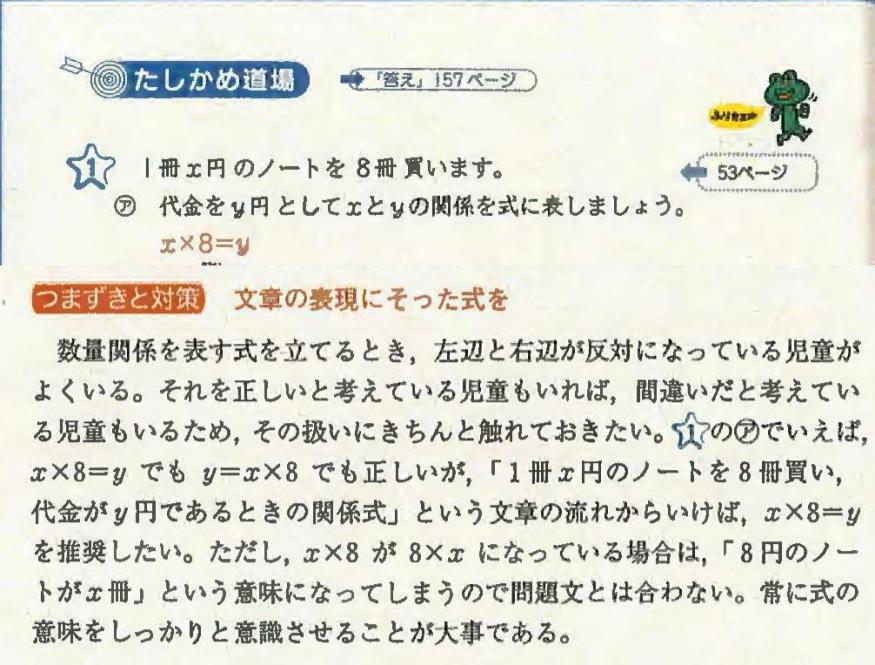【RocketNews24】Japanese elementary school teachers may tell you “5 x 100 = 500” is wrong
Posted by Michelle Lynn Dinh (Shimane-ken, Chibu-mura, 2010–13), editor and writer for RocketNews24. The following article was written by Master Blaster, writing team for RocketNews24, a Japan-based site dedicated to bringing fun and quirky news from Asia to English speaking audiences.
Here’s an elementary school math question for you all:
Apples are sold for 100 yen each. If you buy 5 what is the total amount?
If you said “5 × 100 = 500” then I’m sorry but you just flunked second grade math in Japan… if there were only one question all year. The reason is an old teaching method that is employed in elementary and middle schools throughout the country. It’s also a method that many, such as a blogger by the name of Uncorrelated, want stopped as it leads to strange logic where six times seven does not always equal 42 and five times 100 might not equal 500.
It’s almost an annual event around the internet as someone’s young child with hope for a brighter future comes home with red pen all over their “correctly done” test or homework. Let’s start with a typical example from twitter. This photo was tweeted with the caption: “My co-worker’s son’s grade two math test was returned but I can’t understand why he got this wrong…”
The question reads, “There are six couches. Seven people sit on each couch, so how many people are sitting all together?” As we can see, the child showed his work using the seven times tables (my least favorite of them all) and put the answer as “42 people” even remembering the units.
However, the teacher has corrected the child’s mistake of “6 × 7 = 42” with the much more correct “7 × 6 = 42” explaining that it’s “seven people times six seats” not the other way around!
The following photo has been well circulated around the internet and appears to show a question from a teacher’s guide along with an explanation of the answer.
The question and given answer read:
1) There are x-yen notebooks 8 of which are bought.
A: If y-yen is the total price, write a formula to express the relation between x and y.
x × 8 = y
Then there is an explanation of this question for the teacher’s reference which says:
When making a formula that expresses a quantity relationship, children often reverse the left and right hand sides. If children are taught this is okay, then the children are being taught wrong, so you want to address this awkwardness properly. In terms of question 1-A; x × 8 = y or y = x × 8 is correct. If you follow the flow of the text “x-yen notebooks, eight of which are being bought; the formula when the price is y yen” you should say x × 8 = y. However in the case that x × 8 becomes 8 × x the meaning becomes “8-yen notebooks, x of which are being bought” and is not the same as this problem. It is always important to firmly make them aware of the formula’s meaning.
Some, including Uncorrelated, question whether this is an authentic teacher’s manual especially due to the final sentence referring to the formula having “meaning” which the writers seemed to have just invented. Uncorrelated argues that this logic flies in the face of commutative properties which are taught shortly after in the school system. Commutative properties compare the functions of addition and multiplication to achieve the same result such as 2 × 3 = 3 × 2 = 2 + 1 + 3 = 3 + 2 + 1.
Taking this one step further, Uncorrelated points out that the formula seems based on the wording of the question which itself can be rearranged more than one way. In fact, if we use a more natural English translation of the question: “8 x-yen notebooks are being bought” this would suggest that 8 × x = y is the “only” correct answer that matches the question. This would render an “important rule” to be completely arbitrary and kind of absurd.
On the other hand, there is something to be said for the clarity of a unified format for expressing formulas and values. It’s one thing to have a genius idea but it’s equally important to have others understand it as well. If I went shopping and the clerk told me my pack of chewing gum cost about 0.025 mL of crude oil from Saudi Arabia, I’d be quite annoyed.
However, I would also be quite impressed at the clerk’s creativity, and that’s what children should be encouraged to have at such a young age. Rather than drilling useless dogma with regards to math, they should be allowed to see numbers in their own way with just enough guidance to help them through. That tends to be when greatness happens.
Source: Blogos – Uncorrelated via Hachima Kiko (Japanese)
Images: Wikipedia – Abrahami, Twitpic – string spirits, Twitter – genkuroki
Related articles from RocketNews24:
- 101 scenes of old Japan: A collection of photos taken over a century ago
- Make way for Ninja Turtle Hello Kitties! Or is it Hello Kitty Ninja Turtles?
- Time to start potty training! Chinese speculators buying up diapers in Japan
Are you a writer? RocketNews24 English is hiring!





Comments are closed.